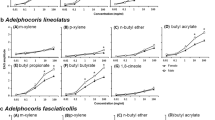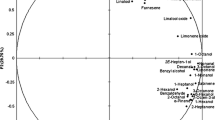Abstract
Induced volatiles provide a signal to foraging predatory insects about the location of their prey. In Iowa, early in the growing season of soybean, Glycine max, many predacious seven-spotted lady beetles, Coccinella septempunctata, were observed on plants with heavy infestations of soybean aphid, Aphis glycines. We studied whether the attraction of this beetle is caused by the release of specific volatile compounds of soybean plants infested by aphids. Volatile compounds emitted by soybean plants infested by aphids were compared with those of undamaged, uninfested, and artificially damaged plants. Gas chromatography–mass spectrometry analyses revealed consistent differences in the profiles of volatile compounds between aphid-infested soybean plants and undamaged ones. Significantly more methyl salicylate was released from infested plants at both the V1 and V2 plant growth stages. However, release patterns of two other induced plant volatiles, (d)-limonene and (E,E)-α-farnesene, differed between the two plant growth stages. Gas chromatographic–electroantennographic detection of volatile extracts from infested soybean plants showed that methyl salicylate elicited significant electrophysiological responses in C. septempunctata. In field tests, traps baited with methyl salicylate were highly attractive to adult C. septempunctata, whereas 2-phenylethanol was most attractive to the lacewing Chrysoperla carnea and syrphid flies. Another common lady beetle, the multicolored Asian lady beetle, Harmonia axyridis, showed no preference for the compounds. These results indicate that C. septempunctata may use methyl salicylate as the olfactory cue for prey location. We also tested the attractiveness of some selected soybean volatiles to alate soybean aphids in the field, and results showed that traps baited with benzaldehyde caught significantly higher numbers of aphids.







Similar content being viewed by others
References
M. L. Bernasconi T. C. J. Turlings L. Ambrosetti P. Bassetti S. Dorn (1998) ArticleTitleHerbivore-induced emissions of maize volatiles repel the corn-leaf aphid, Rhopalosiphum maidis Entomol. Exp. Appl. 87 133–142
J. G. Boer ParticleDe M. Dicke (2004) ArticleTitleThe role of methyl salicylate in prey searching behavior of the predatory mite Phytoseiulus persimilis J. Chem. Ecol. 30 255–271
C. M. Moraes ParticleDe W. J. Lewis P. W. ParÉ H. T. Alborn J. H. Tumlinson (1998) ArticleTitleHerbivore-infested plants selectively attract parasitoids Nature 393 570–573
M. Dicke M. W. Sabelis (1988) ArticleTitleHow plants obtain predatory mites as bodyguards? Neth. J. Zool. 38 148–165
M. Dicke L. E. M. Vet (1999) Plant–carnivore interactions: evolutionary and ecological consequences for plant, herbivore and carnivore H. Olff V. K. Brown R. H. Drent (Eds) Herbivores: Between Plants and Predators Blackwell Science Oxford, UK 485–520
M. Dicke M. W. Sabelis J. Takabayashi J. Bruin M. A. Posthumus (1990) ArticleTitlePlant strategies of manipulating predator–prey interactions through allelochemicals: Prospects for application in pest control J. Chem. Ecol. 16 3091–3118
M. Dicke T. A. Beek ParticleVan M. A. Posthumus C. Schutte O. E. Krip (1998) ArticleTitlePlant–phytoseiid interactions mediated by herbivore-induced plant volatiles: variation in production and in responses of predatory mites Exp. Appl. Acarol. 22 311–333
B. Drukker J. Bruin M. W. Sabelis (2000) ArticleTitleAnthocorid predators learn to associated herbivore-induced plant volatiles with presence or absence of prey Physiol. Entomol. 25 260–265
Y.-J. Du F.-S. Yan X.-L. Han G.-X. Zhang (1994) ArticleTitleOlfaction in host selection of the soybean aphid, Aphis glycines Acta Entomol. Sin. 37 385–391
Y.-J. Du F.-S. Yan J. Tang (1995) ArticleTitleStructure and function of olfactory sensilla on the antennae of soybean aphids, Aphis glycines Acta Entomol. Sin. 38 1–7
Y. Du G. M. Poppy W. Powell J. A. Pickett L. J. Wadhams C. M. Woodcock (1998) ArticleTitleIdentification of semiochemicals released during aphid feeding that attract parasitoid Aphidius ervi J. Chem. Ecol. 24 1355–1368
T. B. Fox D. A. Landis F. F. Cardoso C. D. Difonzo (2004) ArticleTitlePredators suppress Aphis glycines Matsumura population growth in soybean Biol. Control 33 608–618
X.-C. Han (1997) ArticleTitlePopulation dynamics of the soybean aphid, Aphis glycines and its natural enemies in fields Hubei Agric. Sci. 2 22–24
D. G. James (2003) ArticleTitleSynthetic herbivore-induced plant volatiles as field attractants for beneficial insects Environ. Entomol. 32 977–982
S.-H. Liu D. M. Norris P. Lyne (1989) ArticleTitleVolatiles from the foliage of soybean, Glycine max, and Lima bean, Phaseolus lunatus: their behavioral effects on the insects Trichoplusia ni and Epilachna varivestis J. Agric. Food Chem. 37 496–501
P. M. Lösel M. Lindemann J. Scherkenbeck J. Maier B. Engelhard C. A. Campbell J. Hardie J. A. Pickett L. J. Wadhams A. Elbert G. Thielking (1996) ArticleTitleThe potential of semiochemicals for control of Phorodon humuli (Homoptera: Aphididae) Pestic. Sci. 48 293–303
V. Ninkovic A. L. Alnasi J. Petterson (2001) ArticleTitleThe influence of aphid-induced plants volatiles on ladybird beetle searching Biol. Control. 21 191–195
V. Ninkovic E. Ahmed R. Glinwood J. Petterson (2003) ArticleTitleEffects of two types of semiochemical on population development of the bird oat aphid, Rhopalosiphum padi in a barley crop Agric. For. Entomol. 5 27–33
L. P. J. J. Noldus (1989) ArticleTitleSemiochemicals, forging behavior and quality of entomophagous insects for biological control J. Appl. Entomol. 108 425–451
R. Ozawa G. Arimura J. Takabayashi T. Shimoda T. Nishioka (2000) ArticleTitleInvolvement of jasmonate- and salicylate-related signaling pathways for the production of specific herbivore-induced volatiles in plants Plant Cell Physiol. 41 391–398
P. W. Paré J. H. Tumlinson (1999) ArticleTitlePlant volatiles as a defense against insect herbivores Plant Physiol. 121 325–331
V. Shulaev P. Silverman I. Raskin (1997) ArticleTitleAirborne signalling by methyl salicylate in plant pathogen resistance Nature 385 718–721
C. E. M. Boom ParticleVan den T. A. Beek ParticleVan M. A. Posthumus A. Groot ParticleDe M. Dicke (2004) ArticleTitleQualitative and quantitative variation among volatile profiles induced by Tetranychus urticae feeding on plants from various families J. Chem. Ecol. 30 69–89
L. E. M. Vet M. Dicke (1992) ArticleTitleEcology of infochemical use by natural enemies in a tritrophic context Annu. Rev. Entomol. 37 141–172
L. L. Walling (2000) ArticleTitleThe myriad plant responses to herbivores J. Plant Growth Regul. 19 195–216
D. W. Whitman F. J. Eller (1992) ArticleTitleOrientation of Microplitis croceipes (Hymenoptera: Braconidae) to green leaf volatiles: does response curves J. Chem. Ecol. 18 1743–1753
Y. Yang J. Shah D. F. Klessig (1997) ArticleTitleSignal perception and transduction in plant defense responses Genes Dev. 11 1621–1639
J. Zhu A. A. Cossé J. J. Obrycki K. S. Boo T. C. Baker (1999) ArticleTitleOlfactory reactions of the twelve-spotted lady beetle, Coleomegilla maculata, and the green lacewing, Chrysoperla carnea, to semiochemicals released from their prey and host plant: electroantennogram and behavioral responses J. Chem. Ecol. 25 1163–1177
Acknowledgments
We thank Jason Jones for field trapping assistance. This project was supported by funding from National Science Foundation (SBIR) and Iowa Department of Natural Resources and The Leopold Center for Sustainable Agriculture to J.Z.
Author information
Authors and Affiliations
Corresponding author
Rights and permissions
About this article
Cite this article
Zhu, J., Park, KC. Methyl Salicylate, a Soybean Aphid-Induced Plant Volatile Attractive to the Predator Coccinella septempunctata. J Chem Ecol 31, 1733–1746 (2005). https://doi.org/10.1007/s10886-005-5923-8
Received:
Revised:
Accepted:
Published:
Issue Date:
DOI: https://doi.org/10.1007/s10886-005-5923-8




